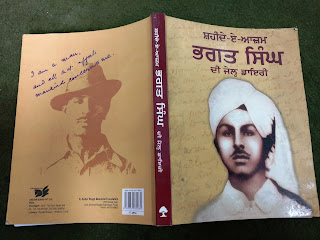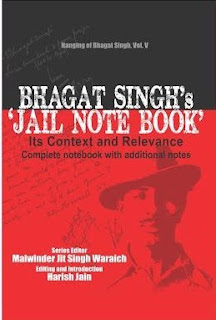A short publication history of Bhagat Singh's Jail Notebook
Chaman Lal (prof.chaman@gmail.com) recently retired from the Centre for Indian Languages, School of Languages and Cultural Studies, Jawaharlal Nehru University
A biographer of Bhagat Singh and a chronicler of his works, writes about the publication history of Bhagat Singh’s “Jail Notebook”. This article is being published, when reports have talked about the possible release of the Notebook “for the first time” by the Gujarat Chief Minister Narendra Modi.
Almost anyone who is a serious admirer of the revolutionary Bhagat Singh would know about his “Jail Notebook” today; yet before 1981, hardly anyone other than Bhagat Singh’s closest family members knew about its existence. During the 50th anniversary of the martyrdom of Hindustan Socialist Republican Army activists Bhagat Singh, Rajguru and Sukhdev in 1981, Singh’s brother Kulbir Singh allowed a microfilm of the book to be made by the National Archives of India (NAI) and the Nehru Memorial Museum and Library (NMML). He did so on the condition that the Notebook should not be published. The Jail Notebook was put on exhibition at the National Archives of India along with other documents of the revolutionary movements. Both NAI and NMML then kept the Notebook for reference and consultation among their records.
Soon, a copy of the Notebook was provided to “Gurukul” in Inderprastha, Delhi by Kulbir Singh’s younger son Abhey Sandhu. This was the time when L V Mitrokhin, the Russian scholar on Indian history, visited Kulbir Singh many times and obtained either the whole or parts of Notebook, took it to Moscow and wrote about its significance. L V Mitrokhin’s writing on Bhagat Singh’s notebook soon enabled other Indian scholars to pay attention to it. This author had for the first time seen the Notebook in the NMML in 1984, took extensive notes from it, and started writing about it in newspapers and journals.
The Jail Notebook was part of a bagful of documents, which Bhagat Singh had handed over to Kumari Lajjawati, the secretary of the Bhagat Singh defence committee and later principal of a college in Jalandhar. She was instructed by Bhagat Singh to hand over this bag to his comrade Bejoy Kumar Sinha on his release from jail. Sinha was transported for life in the Lahore Conspiracy case and was released in 1938, when the Indian National Congress led governments came to power in many provinces. Lajjawati showed that bag to Lala Feroze Chand, editor of The People, and who himself was a committed socialist. Lala Feroze Chand published a few documents from those papers, including an abridged form of the “Letter To Young Political Workers” written in 2nd Februay 1931, the “Regarding Line of Defence In Hari Kishan's Case[1]” and “Why I am an Atheist” as part of the 27th September 1931 issue to commemorate Bhagat Singh’s first birth anniversary since his execution.
The last mentioned essay was lost during the Partition and many websites today are still carrying re-translated version of this essay from other Indian languages. I had reproduced The People’s first printed version of this essay in my latest book-Understanding Bhagat Singh which was released recently. The People in an editorial note had ascribed copyrights of the essay to S. Kishan Singh, father of Bhagat Singh. Bhagat Singh’s writings were being published from Bhagat Singh’s life time in many Hindi, Punjabi, Urdu and English papers, which were put into a volume for the first time by Virender Sandhu, the niece of Bhagat Singh and daughter of S. Kultar Singh, who was most close to Bhagat Singh’s heart. It was Virender Sandhu, who authored the most authoritative biography of Bhagat Singh’s whole family in 1968 in Hindi. Later Jagmohan Singh, another nephew of Bhagat Singh and son of Bibi Amar Kaur collected more documents and put them a volume in Punjabi titled Bhagat Singh ate Unna de saathiyhan de dastavez (Bhagat Singh and his comrades’ documents).
First Printed Version
Few years later, the monthly Indian Book Chronicle edited by Bhupinder Hooja in Jaipur started serialising the Jail Notebook of Bhagat Singh in 1992. Hooja had received its copy from his elder brother G B Kumar Hooja who had been the vice chancellor of Gurukul Kangri Haridwar (which must have obtained the Notebook’s copy from Gurukul Inderprastha). Bhupender Hooja, having reassured about the authenticity of the Notebook, then employed his resources with a lot of labour in annotating the sources of Bhagat Singh’s mentioned books, writers and quotations. The result was the release of the first printed edition of the Jail Notebook in 1994, which was released in the Jaipur Raj Bhavan by the then governor D P Chattopadhyaya[2]. The Jail Notebook got some good reviews in newspapers, but could not reach a mass readership as its publisher lacked a network of distribution and the book itself lacked enough aesthetic appeal. Yet its Hindi translation and other translations in Punjabi and other languages appeared after a few years, unfortunately without acknowledgment of Hooja’s work as the original editor and annotator.
After I joined the Jawaharlal Nehru University faculty in 2005, I convinced Leftword publications (based in New Delhi) to bring out a new edition of the Notebook and with Bhupinder Hooja’s permission, its new edition was brought out by Leftword in 2007. This was during the birth centenary of Bhagat Singh. The Notebook was supplemented with other essays (articles by Bhagat Singh and also articles on Bhagat Singh such as by EV Ramasamy “Periyar”, and an introduction written by myself). Sudhanva Deshpande, the publisher of the book further improved the annotations, but the main credit of the book remained with Hooja.
The Marathi[3], (two) Bengali[4] and Urdu[5] translations of versions of the Notebook were published in 2007, 2009, 2012 and 2010 respectively. A scanned and printed edition of the Notebook, edited by Babar Singh (the son of Kulbir Singh) and K C Yadav was also published during the centenary year (priced at Rs 999) by Hope India Publications, Gurgaon.
Abhey Sandhu, the younger son of Kulbir Singh, during the birth centenary year of Bhagat Singh, also got the Notebook published by both the Punjab and the Haryana government; in a scanned form by the former and in Punjabi and Hindi translations by the latter. These publications were not priced and were published by the public relations departments of both the governments for free distribution. When I was invited to address the Bhagat Singh youth awardees this year on 28th March at Mohali, I was pleasantly surprised to know that the awardees of the Punjab government were being gifted with a copy of the Jail Notebook. The government had pre-empted what I sought to suggest as part of my speech and I deeply appreciate this gesture.
I remember that there are multiple editions of the revolutionary Ram Prasad Bismil’s autobiography in Hindi and I was pleasantly surprised to see Swami Agnivesh bringing out the edition of that autobiography at just Rs 5 per copy and which his organisation distributed to school students almost free of cost. The Notebook is now part of the Government of India’s publication division; as Shaheed Bhagat Singh:Dastavezon ke Aiene Men, released by the veteran journalist Kuldip Nayar in presence of Abhey Sandhu and Kiranjit Sandhu, two nephews of Bhagat Singh, on 19th December 2007, an anniversary of the martyrdom of the revolutionaries Ram Prasad Bismil and Ashfaqualla Khan.
I understand that some more editions of the Notebook have also been brought out by other publishers and individuals, including by Abhey Sandhu himself. There is no harm in multiple editions of such inspiring books. It is only when someone makes the false claim that the “Jail Notebook is being published for the first time” that one should rightfully take umbrage.
[1] Hari Kishan was tried and executed by the British for shooting at the Punjab governor Geoffrey De Montmorrency at a convocation ceremony of the Punjab University at Lahore on 23rd December 1930.
[2] Hooja acknowledged three of us who had written on Bhagat Singh’s works before – Kamlesh Mohan from Chandigarh, Shiv Verma, the communist leader who was a comrade of Bhagat Singh from his HSRA days and me. All three of us had written on Bhagat Singh’s ideology and his works.
[3] The Marathi version was a translated form of my Hindi book – Bhagat Singh ke Sampooran Dastavez (2004).
[5] Some parts of the Notebook were published in Urdu in the Urdu version of my book – Bhagat Singh ke Syaasi Dastavez (2010)
- See more at: http://www.epw.in/journal/
Since then more editions of Jail Notebook have come out. One in Kannada this very year-2016, one more by Yadwinder Sandhu, translated in Marathi as well. And the latest one edited by Harish Jain from Chandigarh, but none gave credit to late Sh. Bhupender Hooja except translated ones from mine compiled work by Leftword, in Hindi, Kannada and Bengali, where the credit, even agreement was signed with Bhupender Hooja, who is no more among us now. whose 1994 first publication of Jail Diary is pioneering work.
























 formed by Ashfaqullah Khan and Mahavir Singh in around 1925, became the Hindustan Socialist Republican Association (HSRA) in 1928 primarily on the insistence of Bhagat Singh. Along with an express commitment towards socialism, the HSRA also proclaimed a broad internationalist vision of a World Order that would free humanity from the scourge of capitalism and imperialist wars. Naujawan Bharat Sabha (NBS) was founded in Lahore in 1926 as the open front of HSRA with object to expose reactionary politics and to promote religious harmony and secularism. In June 1928, Bhagat Singh and Sukhdev also organized a Lahore Students’ Union as auxiliary to NBS. The outlook of NBS was clearly popular. “Revolution by the masses and for the masses”, stated the Manifesto of the NBS. NBS made remarkable progress within a few months as its branches were organized all around India. It became so popular that it was banned by the British government in May of 1930.
formed by Ashfaqullah Khan and Mahavir Singh in around 1925, became the Hindustan Socialist Republican Association (HSRA) in 1928 primarily on the insistence of Bhagat Singh. Along with an express commitment towards socialism, the HSRA also proclaimed a broad internationalist vision of a World Order that would free humanity from the scourge of capitalism and imperialist wars. Naujawan Bharat Sabha (NBS) was founded in Lahore in 1926 as the open front of HSRA with object to expose reactionary politics and to promote religious harmony and secularism. In June 1928, Bhagat Singh and Sukhdev also organized a Lahore Students’ Union as auxiliary to NBS. The outlook of NBS was clearly popular. “Revolution by the masses and for the masses”, stated the Manifesto of the NBS. NBS made remarkable progress within a few months as its branches were organized all around India. It became so popular that it was banned by the British government in May of 1930.